|
Luxury on the Line
by Bob Brooke
On September 27, 1825,
English passengers boarded a “goods” or freight train from Stockton to
Darlington, a distance of 12 miles. Historians regard this as the first
train to carry passengers. A month later the Stockton and Darlington
Railroad added a daily “coach” car, modeled after a stagecoach. It
carried 6 passengers inside and 15 to 20 outside. They each paid one
shilling and could each bring along 14 pounds of baggage.
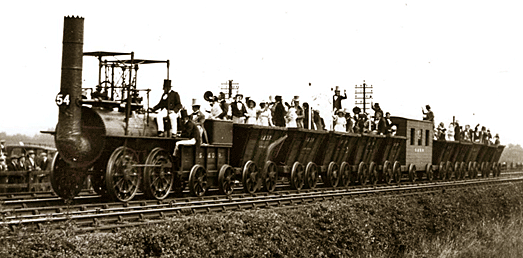
Though riding the early rails was a step above the canal boat and
stagecoach, rail travel left a lot to be desired. The floor of the car
lay low and flat, and passengers sat jammed into narrow seats with stiff
backs, so they felt every bump. Winter travel was especially difficult.
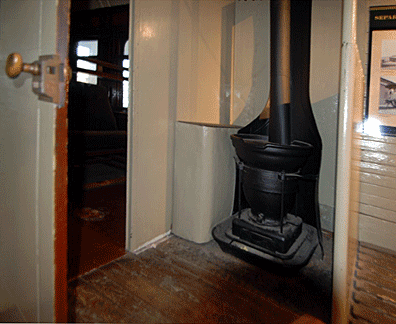 A
stove at each end provided heat to those nearest to it, but those seated
in the middle of the car nearly frze. And with little ventilation, all
nearly suffocated from carbon monoxide. Tallow candles furnished a “dim
religious light,” and emitted a putrid odor. Dust suffocated parched
passengers in dry weather since the windows had no screens. And since
there were no adequate spark arresters on the engine, passengers at the
end of their journey looked as if they had spent the day in a blacksmith
shop. A
stove at each end provided heat to those nearest to it, but those seated
in the middle of the car nearly frze. And with little ventilation, all
nearly suffocated from carbon monoxide. Tallow candles furnished a “dim
religious light,” and emitted a putrid odor. Dust suffocated parched
passengers in dry weather since the windows had no screens. And since
there were no adequate spark arresters on the engine, passengers at the
end of their journey looked as if they had spent the day in a blacksmith
shop.
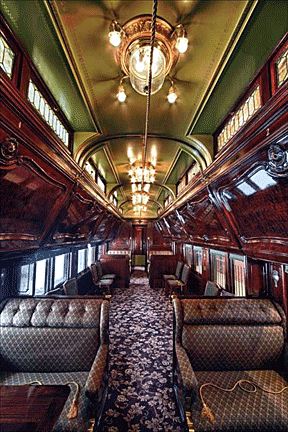 With
hard springs, the movement of cars over poorly laid track jolted
passengers and rattled windows, making conversation a luxury. Early
trains might as well not have had brakes, for those they did have were
clumsy and of little use. With
hard springs, the movement of cars over poorly laid track jolted
passengers and rattled windows, making conversation a luxury. Early
trains might as well not have had brakes, for those they did have were
clumsy and of little use.
Every year showed progress in perfecting the comforts and safety of
railway cars. Air brakes allowed trains to be stopped in an incredibly
short time with the help of the vacuum-brake which powered the brakes
exhausting the air. So passengers waiting on station platforms were
often in danger.
Improvements in rolling stock had reduced the jerking, jolting, and
oscillation of the cars. Plus the rail beds had been properly ditched,
drained, and ballasted with broken
stone or gravel, the dust overcome, the sparks arrested, so cleanliness
had at last been made possible on a railway train.
One of the first comforts the railroads addressed was heating the cars.
This came about through the invention of a method for circulating hot
water from the boiler of the locomotive through pipes running near the
floor of the cars. Not only did passengers now have warm feet, but the
loss of life from train fires originating from stoves had been halted.
However, heating a detached car was still a problem until the discovery
of electricity.
The Concept of Luxury Trail Travel is
Born
The idea that traveling by train could be luxurious began in the 1880s
as the number of international visitors to England and the Continent
skyrocketed.
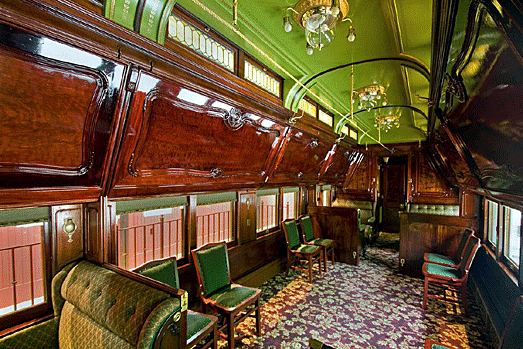
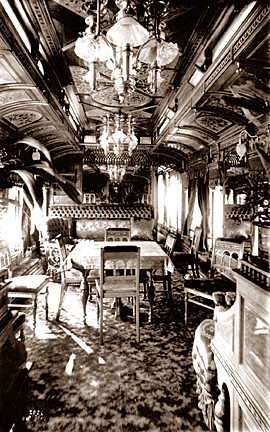 This
was slow to get started In England. But in the United States, steamboats
had made great progress offering passengers luxurious comforts-–berths
to sleep in, meals served in spacious cabins, and entertainment on
board. To compete, the railroads had to make riding their trains more
comfortable. This
was slow to get started In England. But in the United States, steamboats
had made great progress offering passengers luxurious comforts-–berths
to sleep in, meals served in spacious cabins, and entertainment on
board. To compete, the railroads had to make riding their trains more
comfortable.
Although the last four decades before World War I saw first-class rail
passengers treated to unprecedented privileges and luxuries, this period
can also be regarded as one in which many of the older comforts enjoyed
by the superior-class passenger were offered to everyone.
American and British practice continued to diverge in passenger car
design. The British still preferred compartments, while the Americans
stayed with the open car and central aisle. British sleeping cars were
for night use only. unlike those of the Pullman type.
The relative speed and ability to travel regardless of the weather made
rail travel attractive to travelers and businesses. But unlike its
European counterparts, American railroads developed a passenger car with
one compartment, containing an aisle down the middle. This ran on two
trucks containing four wheels each, making it easier to navigate sharp
curves.
The Dining Car
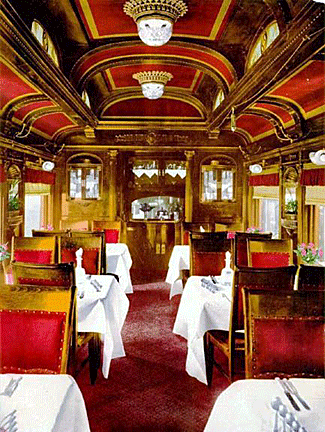 But
that still wasn’t enough to supply the wants of the growing number of
railway passengers. So the dining car came next. A complete restaurant,
with a large kitchen and pantries at one end and the main body of the
car fitted up as a dining room, it offered a place in which all the
passengers in the train could take their meals comfortably. Pullman
named his first dining car the “Delmonico,” which began service in 1868
on the Chicago & Alton Railroad. High quality dining cars provided fine
dining on the move. But
that still wasn’t enough to supply the wants of the growing number of
railway passengers. So the dining car came next. A complete restaurant,
with a large kitchen and pantries at one end and the main body of the
car fitted up as a dining room, it offered a place in which all the
passengers in the train could take their meals comfortably. Pullman
named his first dining car the “Delmonico,” which began service in 1868
on the Chicago & Alton Railroad. High quality dining cars provided fine
dining on the move.
With the introduction of the dining car came the concept of the
continuous train. This necessitated that passengers had to walk from one
car to another across platforms to get to the parlor or dining cars
while the train was in motion, an act that they had been cautioned
against. The railroads realized they had to come up with a solution to
the problem if the continuous train concept were to be successful,
particularly for limited express trains.
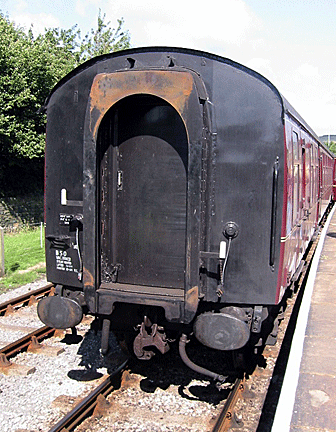 Access
to the diner over the open platform ends of each car was inconvenient
and often dangerous, so railroads sought a better means of crossing from
one car to another was sought. The solution, patented in 1887, was
invented by A superintendent at the Pullman Works invented the solution,
an open metal frame suspended at the end of each car and bearing against
a similar frame on the adjoining car. He attached concertina bellows to
it to form a walkway, then narrowed the previously open end platform and
enclosed it to form a vestibule, making a completely enclosed passage
between two cars. For more than a decade the 'vestibule train' was the
most heavily advertised offering of United States railroads. Access
to the diner over the open platform ends of each car was inconvenient
and often dangerous, so railroads sought a better means of crossing from
one car to another was sought. The solution, patented in 1887, was
invented by A superintendent at the Pullman Works invented the solution,
an open metal frame suspended at the end of each car and bearing against
a similar frame on the adjoining car. He attached concertina bellows to
it to form a walkway, then narrowed the previously open end platform and
enclosed it to form a vestibule, making a completely enclosed passage
between two cars. For more than a decade the 'vestibule train' was the
most heavily advertised offering of United States railroads.
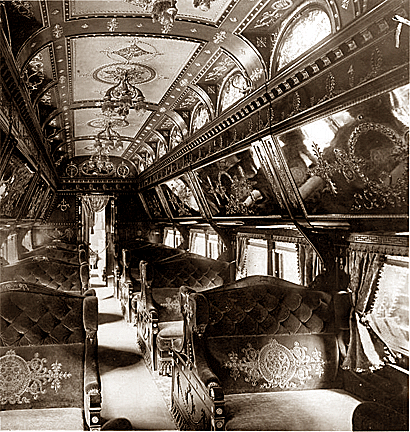 In Britain the better longer-distance trains were corridor trains with
dining cars, and these were the first to he so equipped. Another
American feature which became popular in Britain for some decades was
the raised longitudinal central roof section, or clerestory, which
provided extra window area and also a space to suspend the lamps.
In Britain the better longer-distance trains were corridor trains with
dining cars, and these were the first to he so equipped. Another
American feature which became popular in Britain for some decades was
the raised longitudinal central roof section, or clerestory, which
provided extra window area and also a space to suspend the lamps.
Train lighting had developed from nothing, at the start of the Railway
Age, to candles, oil lamps, and then gas lamps. Oil and gas were liable
to ignite disastrously in accidents, so electric lighting had advantages
of safety as well as of lack of smell and convenience. In Britain, steam
heating meant the gradual disappearance of the foot warmer. The latter
was a metal canister, recharged at main stations, in side which a
chemical process provided moderate heat.
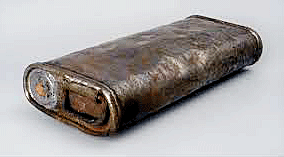 In the aftermath of train fires here were often short-lived public
demands for all-metal passenger cars, and by 1914 this solution was in
sight. The reason, however, was not safety but the increasing cost of
the kind of timber needed for making cm frames, and the space-saving
virtue of steel construction . By 1909 50 percent of American passenger
car orders were entirely for all steel types.
In the aftermath of train fires here were often short-lived public
demands for all-metal passenger cars, and by 1914 this solution was in
sight. The reason, however, was not safety but the increasing cost of
the kind of timber needed for making cm frames, and the space-saving
virtue of steel construction . By 1909 50 percent of American passenger
car orders were entirely for all steel types.
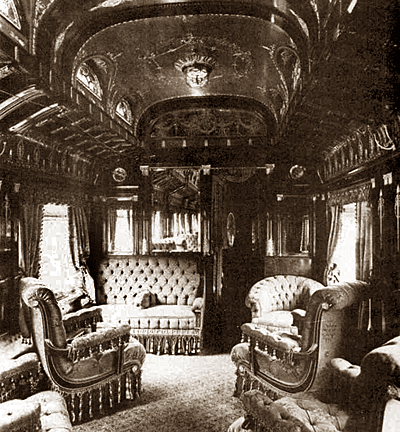 The
chair, or parlor car provided for daytime passengers on long-distance
trains in North America a more comfortable seating and often included a
beverage service. Placed at the tail-end of a train, they each had an
observation platform at the rear end. These cars became a typical
feature of the long-distance American train and political candidates
often used them on their “whistle stop” tours across the country. The
chair, or parlor car provided for daytime passengers on long-distance
trains in North America a more comfortable seating and often included a
beverage service. Placed at the tail-end of a train, they each had an
observation platform at the rear end. These cars became a typical
feature of the long-distance American train and political candidates
often used them on their “whistle stop” tours across the country.
The Orient Express
In 1882, Georges Nagelmackers, a Belgian banker's son, conceived of the
idea of a luxury railway trip of 1,243 miles on his Train Eclair de luxe,
or “lightning luxury train.”
Nagelmackers founded the Compagnie Internationale des Wagons-Lits, which
eventually expanded its luxury trains, travel agencies and hotels all
over Europe, Asia, and North Africa. Its most famous train was the
Orient Express, composed of a baggage car, four sleeping coaches with
beds for 56 passengers, and a restaurant car.
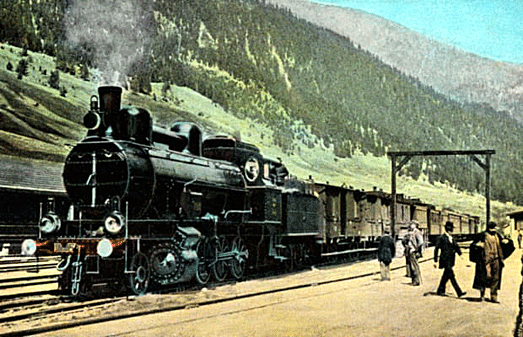
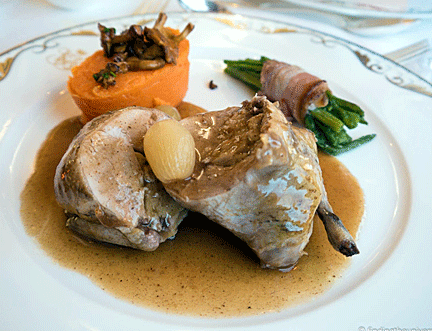 The
original route, which first ran on October 4, 1883, departed from Paris,
Gare de l'Est, to Giurgiu in Romania via Munich and Vienna. At Giurgiu,
passengers ferried across the Danube to Ruse, Bulgaria, to pick up
another train to Varna. They then completed their journey to Istanbul by
ferry. In 1885, another route began operations, this time reaching
Istanbul by rail from Vienna to Belgrade and Niš, then by carriage to
Plovdiv, and by rail again to Istanbul. The
original route, which first ran on October 4, 1883, departed from Paris,
Gare de l'Est, to Giurgiu in Romania via Munich and Vienna. At Giurgiu,
passengers ferried across the Danube to Ruse, Bulgaria, to pick up
another train to Varna. They then completed their journey to Istanbul by
ferry. In 1885, another route began operations, this time reaching
Istanbul by rail from Vienna to Belgrade and Niš, then by carriage to
Plovdiv, and by rail again to Istanbul.
The first menu on board consisted of oysters, soup with Italian pasta,
turbot with green sauce, chicken ŕ la chasseur, fillet of beef with
château potatoes, chaud-froid of game animals, lettuce, chocolate
pudding, and a buffet of desserts.
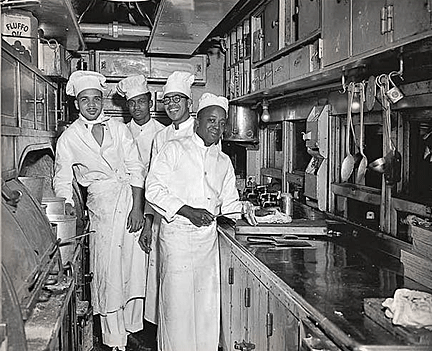 The
idea of sumptuous accommodations and fine food caught the public’s eye.
Passengers universally received the fine cuisine delivered by a small
band of chefs working in cramped conditions. Wealthy British passengers
in particular loved the service and went on to form the majority of the
luxury train’s customers who wanted to experience the better things in
life which the Orient Express offered. The end of the Victorian Age
brought on a time of decadence that altered rail travel as passengers
demanded the best money could buy. The Orient Express was a showcase of
luxury and comfort at a time when traveling was, for the most part,
still rough and dangerous. The
idea of sumptuous accommodations and fine food caught the public’s eye.
Passengers universally received the fine cuisine delivered by a small
band of chefs working in cramped conditions. Wealthy British passengers
in particular loved the service and went on to form the majority of the
luxury train’s customers who wanted to experience the better things in
life which the Orient Express offered. The end of the Victorian Age
brought on a time of decadence that altered rail travel as passengers
demanded the best money could buy. The Orient Express was a showcase of
luxury and comfort at a time when traveling was, for the most part,
still rough and dangerous.
The 1930s saw the Orient Express services at their most popular, with
three parallel services operating----the Orient Express, the Simplon
Orient Express, and also the Arlberg Orient Express, which ran via
Zürich and Innsbruck to Budapest, with sleeper cars running onwards from
there to Bucharest and Athens. During this time, the Orient Express
acquired its reputation for comfort and luxury, carrying sleeping-cars
with permanent service and restaurant cars known for the quality of
their cuisine. Royalty, nobles, diplomats, business people, and the
bourgeoisie in general patronized it.
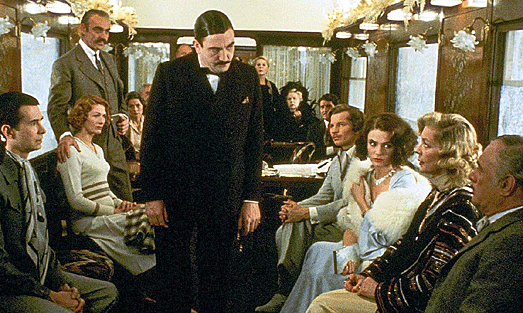
It was during this time that mystery author Agatha Christie published
her famous novel, Murder on the Orient Express. However, Agatha
Christie's Murder on the Orient Express isn't set on the Orient Express
but on the Simplon Orient Express. By the 1920s and 30s there were a
whole inter-connecting network of Wagons-Lits Company trains with Orient
Express as part of their name in addition to the Orient Express, itself.
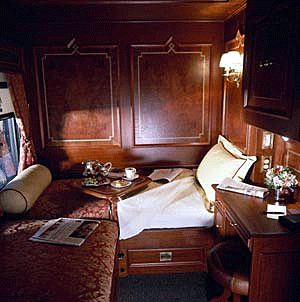 The
sleeping-car from Istanbul to Calais would usually be a 1927-built
S-type, as would the cars to Berlin, Prague, Oostende & Paris Est via
Vienna. The Istanbul-Paris (via Venice) sleeping car would be a slightly
grander 1929-built LX-type. Each car has 10 wood-paneled compartments
with (upper & lower berths plus a washbasin—there were no baths or
showers on board. The sleeper compartments converted for daytime use
into a compact carpeted sitting room with sofa and small table. An
attendant looked after each sleeping-car. There was no lounge, no bar,
no pianos, no coach car of any kind, at least not east of Trieste.
Agatha Christie needed a salon-Pullman car for dramatic purposes in
Murder on the Orient Express, so used some dramatic licence and wrote
one into her story. Very wealthy passengers traveling alone might pay
for sole occupancy of a two-bed compartment, but other passengers would
share a compartment with another passenger of the same sex, Hercule
Poirot himself did. The
sleeping-car from Istanbul to Calais would usually be a 1927-built
S-type, as would the cars to Berlin, Prague, Oostende & Paris Est via
Vienna. The Istanbul-Paris (via Venice) sleeping car would be a slightly
grander 1929-built LX-type. Each car has 10 wood-paneled compartments
with (upper & lower berths plus a washbasin—there were no baths or
showers on board. The sleeper compartments converted for daytime use
into a compact carpeted sitting room with sofa and small table. An
attendant looked after each sleeping-car. There was no lounge, no bar,
no pianos, no coach car of any kind, at least not east of Trieste.
Agatha Christie needed a salon-Pullman car for dramatic purposes in
Murder on the Orient Express, so used some dramatic licence and wrote
one into her story. Very wealthy passengers traveling alone might pay
for sole occupancy of a two-bed compartment, but other passengers would
share a compartment with another passenger of the same sex, Hercule
Poirot himself did.
By Edwardian times
affluent first-class passengers increased substantially; the new
Southern Belle Pullman was described as “The Most Luxurious Train in the
World” when launched in 1908.
<
More Special Features
Next Article > |
